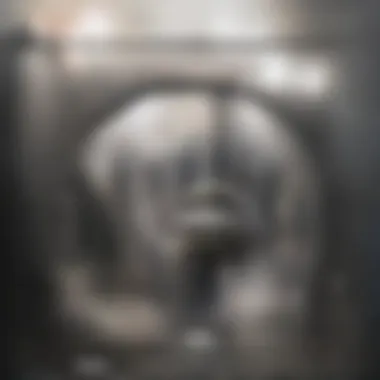Understanding Capular Contraction: Mechanisms and Applications


Intro
Capular contraction is an emerging topic in the field of physiology and medicine. This concept encompasses various biological mechanisms and clinical implications that are critical to both health and disease. Understanding the nuances of this phenomenon is essential for students, researchers, educators, and professionals alike, as it bridges gaps between theoretical knowledge and practical applications.
The focus on capular contraction stems from its significant role in various physiological processes. This article aims to dissect the underlying mechanisms of capular contraction, elucidating its importance in specific health conditions and its potential roles in therapeutic practices. By addressing the biological intricacies and implications, the content provides a comprehensive narrative that seeks to enhance understanding in this specialized area.
Key Findings
Summary of the main results
Research highlights several key facets of capular contraction:
- Definition and Mechanism: Capular contraction is characterized by the shortening of the capsule surrounding joints and organs. This process is primarily governed by muscular and connective tissues responding to various stimuli.
- Physiological Role: It plays a crucial role in joint stability, movement efficiency, and coordination within the body.
- Clinical Significance: Anomalies in capular contraction can lead to conditions such as joint immobility, inflammation, and pain. Understanding these dysfunctions aids in developing effective treatment protocols.
Significance of findings within the scientific community
The continued exploration of capular contraction has profound implications:
- Advancement of Rehabilitation Techniques: Insights from ongoing studies can lead to better rehabilitation strategies for patients suffering from musculoskeletal disorders.
- Interdisciplinary Relevance: Findings can find applications in diverse fields like sports sciences, orthopedics, and physical therapy, thereby fostering collaboration across specialties.
"Understanding capular contraction is not just an academic exercise; it is a vital part of addressing real-world health challenges."
Implications of the Research
Applications of findings in real-world scenarios
The practical implications of understanding capular contraction are numerous:
- Improving Diagnostic Techniques: Knowledge of capular contraction can enhance diagnostic approaches for joint-related disorders.
- Innovations in Treatment: Research outcomes can inform surgical procedures and non-invasive therapies, leading to optimized patient care.
Potential impact on future research directions
Future studies could explore:
- Molecular Pathways: Investigating the cellular mechanisms driving capular contraction could yield new therapeutic targets.
- Longitudinal Studies: Long-term investigations may provide greater insight into how capular contraction affects overall health and well-being across different demographics.
By clearly defining and exploring the intricacies of capular contraction, this article aims to offer valuable insights for those engaged in health sciences. Each finding contributes to a broader understanding that has both immediate relevance and potential for future exploration in the field.
Intro to Capular Contraction
Capular contraction is a fundamental topic for various fields, including biology, medicine, and sports science. Understanding this concept is crucial as it provides insights into muscle dynamics, joint stability, and rehabilitation processes. This section illuminates the mechanisms behind capular contraction, offering a base for discussing its implications and applications.
Definition and Basic Concept
Capular contraction refers to the process where muscle fibers within a joint capsule engage and shorten, resulting in the stabilization and movement of the joint. This phenomenon is critical in maintaining proper joint function and ensuring the body's musculoskeletal system operates efficiently. The basic concept involves muscle contraction linked to signals received from the nervous system, particularly at the neuromuscular junction, where motor neurons connect with muscle fibers. The interaction between these components facilitates a coordinated response, enabling precise movements and adaptations in various physical activities.
Historical Context
The exploration of capular contraction has evolved over centuries. Early anatomical studies recognized the importance of muscles in joint mechanics. The pioneering work of scientists like Giovanni Alfonso Borelli in the 17th century laid the groundwork for understanding biomechanics. Later, advances in physiology, particularly in the 19th century, led to detailed studies on muscle metabolism and neuromuscular physiology. Notably, with the introduction of electromyography in the 20th century, researchers gained deeper insights into how muscles contract. Today, capular contraction is studied through a modern lens, integrating findings from various disciplines, which enhances both clinical applications and athletic training methodologies.
"Understanding capular contraction not only deepens our knowledge of physiology but also improves our approaches to rehabilitation and performance training."


The significance of capular contraction extends beyond academic interest. Components such as this have direct applications in diagnosing joint disorders and optimizing sports training techniques. Any advancements made in understanding the underlying mechanisms can contribute to improved physical care and athletic performance.
Biological Mechanisms of Capular Contraction
The biological mechanisms of capular contraction are essential for understanding how this phenomenon operates at a cellular and structural level. Capular contraction refers to the contraction of the ligaments and tissues surrounding a joint. These mechanisms play a crucial role in maintaining joint function, stability, and overall mobility in organisms. By examining these mechanisms, one gains insight into the physiological processes that sustain bodily functions and potentially illuminate various disorders associated with joint movement.
Muscle Fiber Types and Composition
Muscle fibers are classified into different types based on their structure and function. The two primary types are Type I and Type II muscle fibers. Type I fibers, also known as slow-twitch fibers, are more endurance-oriented. They are resistant to fatigue and are primarily used in activities of low intensity and longer duration, such as in maintaining posture or during aerobic exercises. On the other hand, Type II fibers, or fast-twitch fibers, are designed for quick, powerful bursts of movement, but they fatigue quickly.
The composition of muscle fibers influences capular contraction. Type II fibers contribute significantly to rapid joint movements, while Type I fibers support sustained contractions during activities like walking or standing. The balance between these fiber types is crucial for normal joint function and effective capular contraction. If one type predominates, it can lead to muscle imbalances and impact joint stability.
Neuromuscular Junction and Signaling Pathways
The neuromuscular junction serves as a critical site where nerves communicate with muscles. When an electrical impulse fires down a motor neuron, neurotransmitters are released at the neuromuscular junction. This process stimulates muscle contraction by activating the muscle fibers. The signaling pathways involved in this process are complex and tightly regulated.
Dysfunction at the neuromuscular junction can lead to impairments in capular contraction. Conditions that affect neurotransmitter release or receptor functionality can result in weakened muscle responses. Understanding these pathways allows for better insight into disorders where capular contraction is compromised.
Role of Calcium Ions
Calcium ions are pivotal in facilitating muscle contraction. When a muscle fiber is stimulated, calcium is released from the sarcoplasmic reticulum into the cytoplasm. This influx of calcium is necessary for the binding of actin and myosin, the two proteins responsible for muscle contraction. The release and subsequent removal of calcium ions are critical in regulating the contraction and relaxation cycle of muscles involved in capular contraction.
An imbalance in calcium levels can lead to disorders. For instance, insufficient calcium may cause weak contractions, while excess calcium can lead to spasms. Therefore, maintaining optimal calcium ion levels is essential for normal muscle function and effective capular contraction.
"Calcium is not just a mineral; it is a vital signaling molecule that directs muscle activities."
Physiological Implications of Capular Contraction
Understanding the physiological implications of capular contraction is crucial in comprehending human movement and health. This section sheds light on how normal contractions affect physiological functions, as well as the complications stemming from abnormalities.
Normal Physiological Function
Capular contraction plays an essential role in maintaining joint integrity and mobility. The capsule surrounding joints helps provide stability through controlled movements. Smooth and efficient contractions allow for flexibility in our range of motion during physical activities. These contractions help prevent injuries during high-impact movements in sports or daily tasks. The synchronized contraction of muscles and capsular fibers ensures that joints function properly.
Moreover, maintaining a balance between stability and mobility is vital. A well-functioning capular contraction supports dynamic movements while protecting against excessive strain on soft tissues. This balance is what allows athletes to perform optimally and without injury.
Abnormalities and Disorders
Abnormalities in capular contraction can lead to significant physiological issues. These disorders often result from injury, overuse, or degenerative conditions. Recognizing these abnormalities is crucial for both diagnosis and treatment.
Examples of Pathological Conditions
One example includes adhesive capsulitis, commonly known as frozen shoulder. This condition is characterized by restricted movement of the shoulder joint. The growth of fibrous tissue in the shoulder capsule limits flexibility. Consequently, it leads to pain and significant impairment in daily activities. This creates a cycle of disuse, worsening the condition further.
Another notable example is capsular laxity, where the capsule becomes overly stretched. This can lead to joint instability, making it prone to dislocations or recurrent injuries. Both conditions highlight the importance of capular integrity and its implications on overall joint health.
Impact on Joint Stability
The stability of a joint heavily relies on effective capular function. Proper contractions help position the bones and maintain congruency within the joint space. On the other hand, dysfunction can result in compromised joint stability, leading to a higher incidence of injuries. Ensureing that the capsule is properly functioning is therefore a priority in rehabilitation and preventive medicine.
Joint stability issues, such as in cases of ligamentous laxity or capsular tightness, can lead to chronic pain syndromes. Moreover, these conditions may require intervention, whether through physical therapy or surgical options. This highlights that addressing capular function is not just an academic exercise; it directly impacts the health and mobility of individuals.


Clinical Relevance of Capular Contraction
Capular contraction plays a pivotal role in various clinical settings. Understanding this concept is crucial as it affects diagnosis, treatment decisions, and outcomes in patients with musculoskeletal issues. The clinical relevance lies not only in the understanding of how capular contraction functions but also in its implications for performance and rehabilitation. This section will discuss diagnostic techniques and treatment approaches, highlighting their importance in managing conditions involving capular contraction.
Diagnostic Techniques
Diagnosing issues related to capular contraction requires a comprehensive approach involving several techniques. These may include:
- Physical Examination: Physicians typically begin with a thorough physical examination, assessing for signs of tightness, inflammation, or limited range of motion in affected joints. This assessment helps discern normal physiological response from pathological conditions.
- Imaging Modalities: Advanced imaging technologies such as MRI and ultrasound can offer clear visualization of the joint capsule and surrounding tissues. These technologies detect abnormalities in the structure, which provides further insight into the impairment of capular contraction.
- Electromyography (EMG): This technique evaluates the electrical activity of muscles during contraction. EMG can help determine the functionality of the involved muscle fibers, consequently aiding in diagnosing specific disorders related to capular contraction.
The selection of a diagnostic method depends on the individual case, underlying conditions, and the clinical context.
Treatment Approaches
Effective treatment of capular contraction issues often involves a combination of physical therapy techniques and, in some cases, surgical interventions. Each approach offers distinct pathways to improve outcomes for patients.
Physical Therapy Techniques
Physical therapy techniques are essential in treating conditions related to capular contraction. These techniques aim to restore function and improve the range of motion in joints. Some widely adopted practices include:
- Manual Therapy: This involves hands-on techniques by the therapist to manipulate the joint and surrounding tissues. It helps in alleviating tightness and promoting movement.
- Exercise Programs: Tailored exercise regimens are designed to strengthen muscles and improve flexibility. This approach is beneficial for enhancing overall joint stability and functionality.
- Modalities: Techniques such as ultrasound, heat, or cold therapy can aid in reducing pain and inflammation, facilitating better movement and recovery.
Physical therapy techniques are advantageous as they generally do not involve surgical risks. They also promote patient education on self-management strategies that can be applied long-term.
Surgical Interventions
In cases where conservative treatments fail, surgical interventions may become necessary. These interventions often focus on relieving pain or correcting structural abnormalities. A few notable procedure types include:
- Arthroscopy: This minimally invasive technique allows direct visualization of the joint through small incisions. Surgeons can remove damaged tissue or repair joint structures affected by capular contraction.
- Capsular Release: In instances of significant contracture, a surgical release of the capsule may be performed to restore mobility. This specific intervention targets restrictions caused by tightness in the joint capsule.
While effective, surgical interventions carry inherent risks and longer recovery times compared to conservative approaches. They may also not guarantee complete resolution of symptoms.
Understanding the clinical relevance of capular contraction extends beyond mere theory; it translates into real-world applications affecting patient care and rehabilitation.
Research Developments in Capular Contraction
The field of research on capular contraction is vital in advancing our understanding of this phenomenon. It connects various disciplines such as physiology, biomechanics, and clinical medicine. Recent studies have illuminated the complex mechanisms underlying capular contraction, offering insights that have implications for both health and disease management.
Key elements of these research developments include the exploration of muscle fiber dynamics, the role of signaling pathways in neuromuscular junctions, and the implications of calcium ion regulation. Such research not only enhances fundamental knowledge but also aids in developing targeted therapies and rehabilitation strategies for related disorders.
"Research in capular contraction can lead to better treatment modalities and injury prevention strategies across various fields."
With an increasing emphasis on interdisciplinary approaches, the relevance of capular contraction research extends beyond isolated physiological study. It informs clinical practices, particularly in improving diagnostic techniques and treatment protocols.
Current Studies and Findings
Current studies focus on understanding the intricacies of capular contraction. Investigations are ongoing into the influence of different muscle fiber types on contraction efficiency. The availability of advanced imaging techniques allows researchers to observe and measure these contractions in real time, providing invaluable data.
Key findings from recent literature indicate:
- Muscle Fiber Composition: Different muscle fiber types exhibit varied contraction characteristics. Type I fibers are more endurance-oriented, while Type II fibers respond more rapidly yet fatigue faster.
- Signal Transmission: Enhanced understanding of the neuromuscular junction has revealed how neurotransmitter release impacts muscle contraction and relaxation cycles.
- Calcium Dynamics: Studies indicate that precise regulation of calcium ions is critical for effective muscle contraction, implicating potential targets for interventions in muscular disorders.


Future Research Directions
Future research in capular contraction holds promise for numerous applications. Areas of exploration might include:
- Innovative Therapeutics: Developing novel treatments for disorders that affect capular contraction can lead to improved rehabilitation strategies. By identifying molecular targets, researchers could design drugs or therapies to modulate contraction efficiency.
- Technological Integration: Advancements in wearable technology and biomechanics can enhance monitoring of muscle function during physical activities, allowing for real-time feedback on capular contraction.
- Workplace Applications: Research into ergonomic solutions can improve safety and efficiency in work environments by better understanding the effects of repetitive motion on capular contraction.
Applications of Capular Contraction in Various Fields
The exploration of capular contraction extends beyond its biological and physiological realms. Its applications have seen growth in various sectors particularly where human mechanics and movement are pivotal. Understanding these applications unveils valuable insights for practitioners, designers, and coaches alike. This section provides an overview of how capular contraction influences sports science, rehabilitation practices, and ergonomic designs, thereby enhancing overall performance, health and safety.
Sports Science and Athletic Training
In sports science, the mechanics of capular contraction play an essential role in enhancing athletic performance. It influences how athletes generate force, maintain optimal joint stability, and recover from injuries. Coaches and trainers assess muscular performance through understanding these contractions. Key considerations include:
- The relationship between muscular endurance and capular contraction.
- How different training methods can modify capular responses.
- Specific conditioning programs that focus on strengthening surrounding musculature to aid stability in joint movements.
Moreover, researchers utilize capular contraction metrics to better understand the biomechanics of high-performance athletes. This understanding helps in refining training regimens, allowing for tailored approaches regarding strength and flexibility to prevent injuries.
Rehabilitation Practices
Rehabilitation practices leverage knowledge of capular contraction to facilitate recovery from injuries and surgeries. Knowledge about how the capular structure responds gives physical therapists crucial information for developing personalized treatment plans. The incorporation of capular movement exercises in protocols can:
- Improve joint function and stability.
- Enhance strength and muscle coordination around the joint.
- Facilitate faster recovery post-injury, thus improving overall outcomes.
The implications of this application extend to conditions such as rotator cuff injuries or shoulder dislocations. Therapists aim to restore the integrity of joint function through targeted rehabilitation practices focusing on capular contraction mechanisms.
Ergonomics and Workplace Design
In the field of ergonomics, understanding capular contraction is vital for creating environments that promote efficiency and reduce injury risks. Workplace designs that account for natural body mechanics and muscular contractions can lead to healthier, more productive employees. Considerations in this area include:
- Designing workstations that support joint stability to prevent repetitive strain injuries.
- Implementing movement protocols that encourage proper capular contractions during daily tasks.
- Training employees on correct body mechanics to ensure long-term joint health.
In sum, enhancing workplace ergonomics with an understanding of capular contraction can lead to improved employee productivity and reduced healthcare costs due to injuries.
"Acknowledging the mechanics of capular contraction not only aids in athletic enhancement but also fosters healthier work environments."
Through these various applications, capular contraction emerges as a multifaceted subject with substantial implications across multiple fields. Proper attention and understanding in each area can lead to significant advancements in performance, recovery, and safety.
Epilogue
The conclusion serves as the final point of synthesis in our exploration of capular contraction. It encapsulates the salient aspects of this topic, emphasizing its relevance in biological sciences and clinical practice. A thorough understanding of capular contraction informs both academic pursuits and practical applications in various disciplines, from sports science to rehabilitation.
Summary of Key Points
In this article, we have dissected various dimensions of capular contraction through pertinent sections:
- Definition and Historical Context: Establishing a foundational understanding of what capular contraction is and how it has evolved in scientific literature.
- Biological Mechanisms: Detailing the underlying biological processes that facilitate this contraction, highlighting muscle fiber types, neuromuscular signaling, and the role of calcium ions.
- Physiological Implications: Exploring both healthy and pathological states where capular contraction plays a critical role.
- Clinical Relevance: Discussing diagnostic techniques and treatment modalities, including physical therapy and surgical interventions tailored to manage disorders arising from abnormal contraction.
- Research Developments: Providing insights into ongoing studies and future research directions.
- Applications: Examining the practical uses of capular contraction in sports science, rehabilitation, and ergonomics.
Each of these headings contributes to a well-rounded understanding of capular contraction, illustrating its multifaceted impact on health and performance.
The Importance of Ongoing Research
Ongoing research is vital for enhancing our comprehension of capular contraction and its implications in various fields. This field has numerous unexplored dimensions that could prove beneficial:
- Innovative Treatments: New therapeutic approaches can emerge from basic and applied research to improve outcomes for individuals with disorders related to abnormal capular contraction.
- Understanding Mechanisms: Continued exploration into muscular and neurological pathways can deepen our knowledge of how capular contraction affects overall mobility and joint stability.
- Development of Guidelines: Research findings can lead to the formulation of best practices in sports science and rehabilitation, aiding in injury prevention and recovery strategies.
In summary, the ongoing investigation into capular contraction is essential for both advancing scientific knowledge and improving clinical outcomes. The integration of these findings into practice can enhance the efficacy of treatment methodologies and ergonomic designs in various professional settings.







